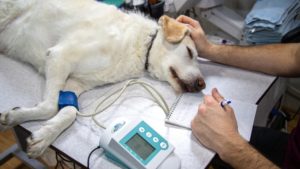Surgery can be a stressful and intimidating experience, not just for us humans but also for our beloved pets. As pet owners, it is important to understand what happens during the pre-operative and post-operative process, so you can be well informed and provide the best care for your pet. In this blog post, we’ll cover the essential steps involved in preparing for pet surgery, including exam, blood work, IV catheter placement, IV fluids, anesthesia, and recovery from anesthesia.
Overnight Fasting: We recommend overnight fasting of the pet. Fasting helps to empty the pet’s stomach, reducing the risk of regurgitation and aspiration of food into the lungs during surgery. Fasting helps to decrease the amount of gas in the pet’s stomach, making it easier to breathe during surgery and reducing the risk of complications during the procedure. Fasting also helps to reduce the risk of complications during the surgery, such as abdominal distension, which can make it more difficult for the veterinarian to perform the procedure.
Exam: Before any surgery, a thorough physical examination of your pet is done to assess their overall health and determine if they are suitable for the procedure. The doctor will check their heart and lung sounds, abdominal palpation, skin condition, and any other physical characteristics relevant to the specific surgery. This examination helps the veterinarian to identify any pre-existing medical conditions that may affect the outcome of the surgery.
Blood Work: Blood work is an essential part of preparing for pet surgery. Blood tests help determine your pet’s liver and kidney function, electrolyte levels, blood sugar levels, and the presence of any infections. These results are crucial in determining whether your pet is fit for anesthesia and surgery and help the vet tailor the anesthesia and pain management plan accordingly.
IV Catheter Placement: An IV (Intravenous) catheter is inserted into your pet’s vein on the leg before the surgery to administer medications and fluids during the procedure. The placement of the catheter helps to ensure that the pet is hydrated, receives necessary medications, and can receive fluids and any additional medicine if needed.
IV Fluids: IV fluids are a crucial part of the pre-operative process as they help keep your pet hydrated and regulate their blood pressure during the procedure. Fluids also help support the pet’s organ function and provide a stable environment for the pet to recover after the surgery. IV fluids are particularly important because of overnight fasting of the pet.

Anesthesia: Anesthesia is used to keep your pet still and pain-free during the surgery. The type of anesthesia used will depend on the procedure, the pet’s age, size, and overall health. Your pet’s vital signs, such as heart rate, respiration, and blood pressure, EKG will be monitored throughout the procedure to ensure their safety.
Pain and antibiotic injections: Depending on type of procedure, your pet will get pain injection and antibiotic injection. This helps in smooth recovery of the pet from anesthesia and prevent any infection after the surgery. You pet may also go home with pain medicine and antibiotics depending on the type of surgery being performed.
Surgical Shaving and Scrubbing: Before the surgery, the area where the incision will be made will be shaved to remove any fur that could interfere with the procedure. This will also allow the veterinarian to have a clear view of the surgical site. Before the surgery, the surgical site will also be scrubbed with an antiseptic solution to reduce the risk of infection. This step is important in removing any bacteria or dirt from the skin to help prevent the spread of infection.
Recovery from Anesthesia: After the surgery, your pet will be monitored and kept warm as they awaken from the anesthesia. This process can take anywhere from a few minutes to a few hours, depending on the type and amount of anesthesia used. During this time, your pet may appear disoriented, dizzy, or confused, but these symptoms should resolve as the pet fully awakens.
Post-surgery Home Care: Here are some steps that you can take to help your pet recover from surgery:

- Pain Management: Your pet may experience pain after surgery, and it is important to provide them with pain medication as directed by the veterinarian. This will help to reduce their discomfort and promote a smoother recovery.
- Monitoring: Keep a close eye on your pet’s behavior, appetite, and energy levels. If you notice any changes, contact us immediately.
- Rest: It is important to provide your pet with a quiet, calm environment to rest and recover. Avoid any strenuous activity or rough play until your pet has fully recovered which is usually 2 weeks for most surgeries.
- Follow-up Appointments: Attend all follow-up appointments to monitor your pet’s progress and address any concerns or complications that may arise.
- Keeping the surgical site clean: Keep the surgical site clean and dry (no bathing for two weeks.) to reduce the risk of infection. Follow the doctor’s instructions on how to care for the surgical site and when to have the stitches removed.
- Diet: Offer your pet a balanced diet to help support their recovery. You may need to provide smaller, more frequent meals if your pet has difficulty eating or drinking after surgery.
In conclusion, preparing your pet for surgery requires careful consideration and attention to detail. At Harmony Pet Clinic we are carefully involved in the process, including exams, blood work, IV catheter placement, IV fluids, anesthesia monitoring, and waking up from anesthesia. By being well informed, you can ensure that your pet receives the best care possible and a smooth and successful recovery at Harmony Pet Clinic.
